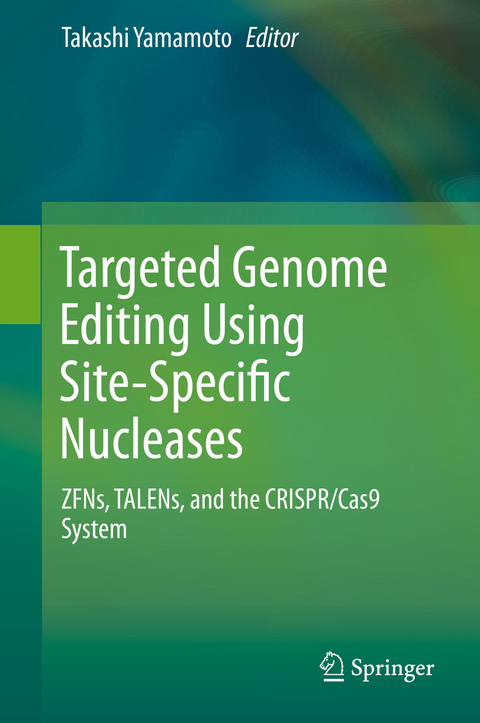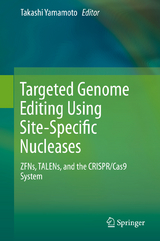Targeted Genome Editing Using Site-Specific Nucleases
This book serves as an introduction to targeted genome editing, beginning with the background of this rapidly developing field and methods for generation of engineered nucleases. Applications of genome editing tools are then described in detail, in iPS cells and diverse organisms such as mice, rats, marine invertebrates, fish, frogs, and plants. Tools that are mentioned include zinc finger nucleases (ZFNs), transcription activator-like effector nucleases (TALENs), and CRISPR/Cas9, all of which have received much attention in recent years as breakthrough technologies. Genome editing with engineered nucleases allows us to precisely change the target genome of living cells and is a powerful way to control functional genes. It is feasible in almost all organisms ranging from bacteria to plants and animals, as well as in cultured cells such as ES and iPS cells. Various genome modifications have proven successful, including gene knockout and knock-in experiments with targeting vectors and chromosomal editing. Genome editing technologies hold great promise for the future, for example in biomedical research, clinical medicine, and generation of crops and livestock with desirable traits. A wide range of readers will find this book interesting, and with its focus on applications in a variety of organisms and cells, the book will be valuable for life scientists in all fields.
Preface.- Part 1 Basics of Genome Editing.- 1 Genome Editing Using Zinc-Finger Nucleases (ZFNs) and Transcription Activator-Like Effector Nucleases (TALENs) (Hiroshi Ochiai and Takashi Yamamoto)-. 2 CRISPR/Cas9: The Leading Edge of Genome Editing Technology (Tetsushi Sakuma and Takashi Yamamoto)-. Part 2 Genome Editing in Cultured Cells and Various Organisms.- 3 Editing in Cultured Human Cells: From Cell Lines to iPS Cells (Hongmei Lisa Li and Akitsu Hotta)-. 4 Genome Editing in Nematode (Takuma Sugi)-. 5 Highly Efficient Targeted Gene Disruption in the Silkworm, Bombyx mori, Using Genome Editing Tools (Takaaki Daimon)-. 6 Genome Editing in Sea Urchin (Naoaki Sakamoto)-. 7 Genome Editing in Ascidians (Nicholas Treen and Yasunori Sasakura)-. 8 Genome Editing in Zebrafish and Medaka (Atsuo Kawahara, Taijiro Yabe, Satoshi Ansai, Shinji Takada, and Masato Kinoshita)-. 9 Genome Editing Using Site-Specific Nucleases in Amphibians (Ken-ichi T. Suzuki and Toshinori Hayashi)-. 10 Genome Editing in Mice Using CRISPR/Cas (Samantha AM Young, Mark Baker, and Masahito Ikawa)-. 11 Genome Editing in Mice Using TALENs (Tomomi Aida)-. 12 Engineered Nucleases Lead to Genome Editing Revolution in Rats (Kazuto Yoshimi, Takehito Kaneko, Birger Voigt, and Tomoji Mashimo)-. 13 Genome Editing in Higher Plants (Yuriko Osakabe and Keishi Osakabe).
| Zusatzinfo | 33 Illustrations, color; 12 Illustrations, black and white; VIII, 205 p. 45 illus., 33 illus. in color. |
|---|---|
| Verlagsort | Tokyo |
| Sprache | englisch |
| Maße | 155 x 235 mm |
| Themenwelt | Naturwissenschaften ► Biologie ► Botanik |
| Naturwissenschaften ► Biologie ► Genetik / Molekularbiologie | |
| Naturwissenschaften ► Biologie ► Zellbiologie | |
| Naturwissenschaften ► Biologie ► Zoologie | |
| Schlagworte | CRISPR/Cas9 • Gene disruption • Gene Knockout • Genome editing • IPS • Knock-in • Talen • Targeted insertion • ZFN |
| ISBN-10 | 4-431-55226-X / 443155226X |
| ISBN-13 | 978-4-431-55226-0 / 9784431552260 |
| Zustand | Neuware |
| Haben Sie eine Frage zum Produkt? |
aus dem Bereich




